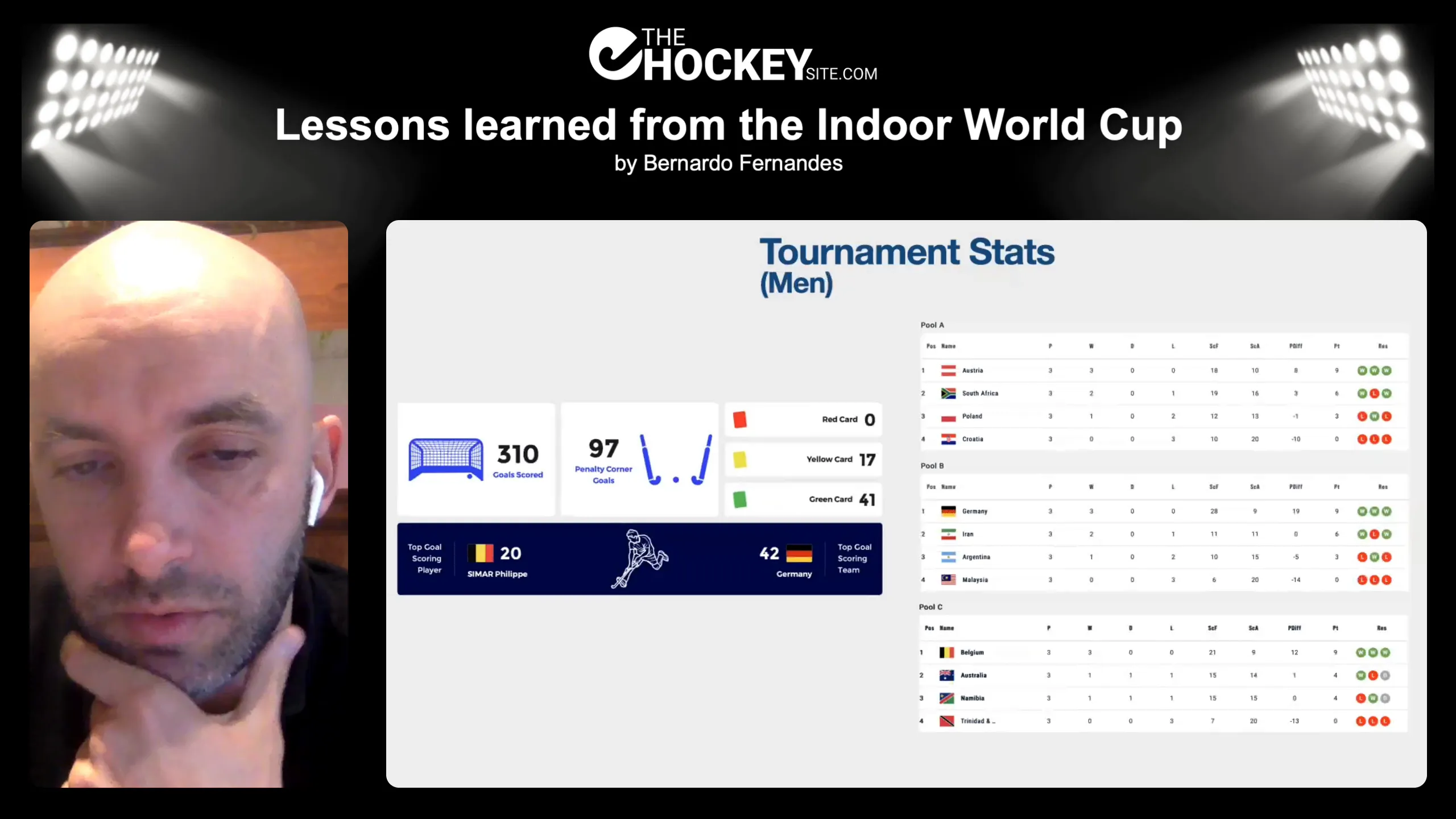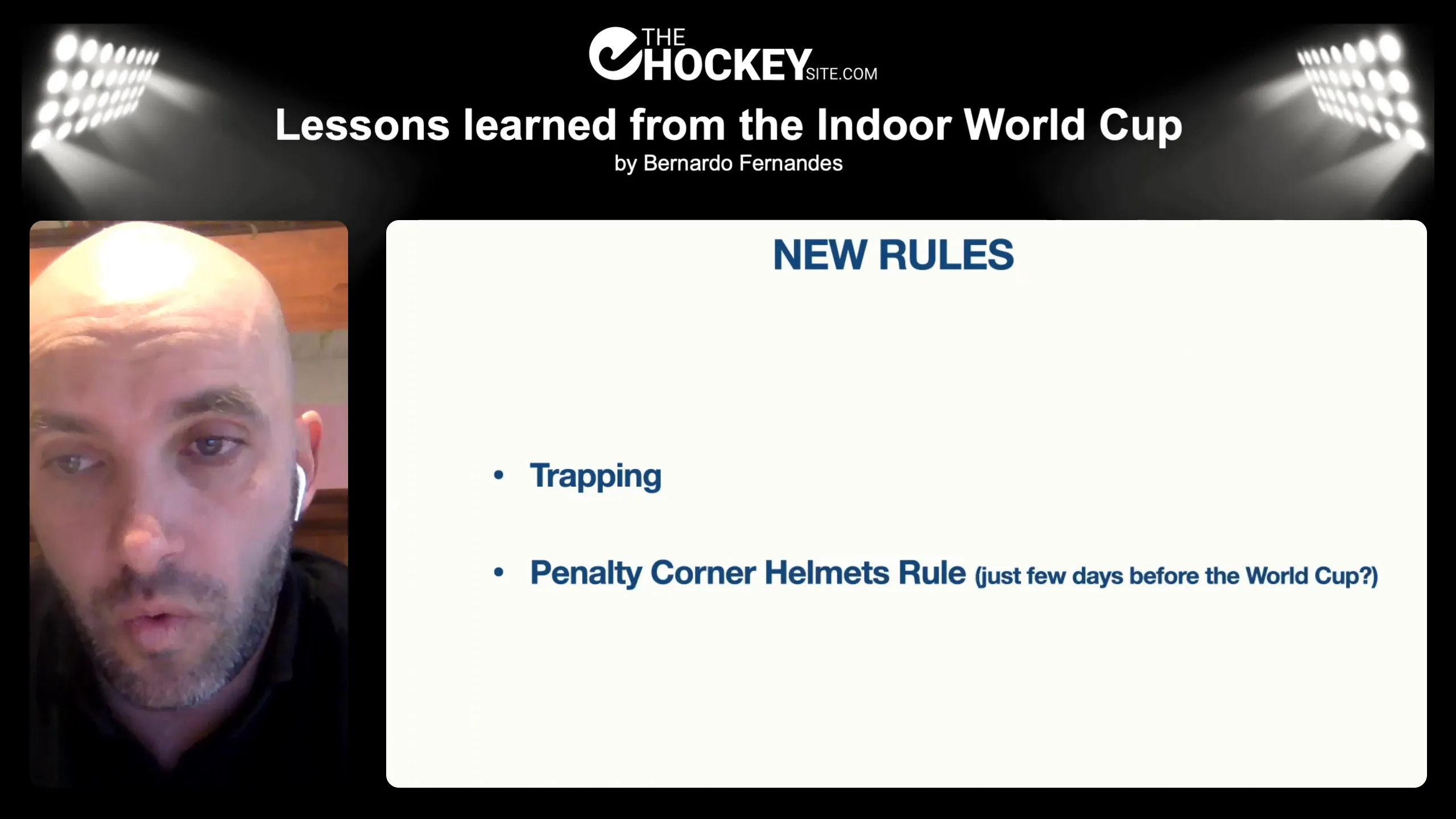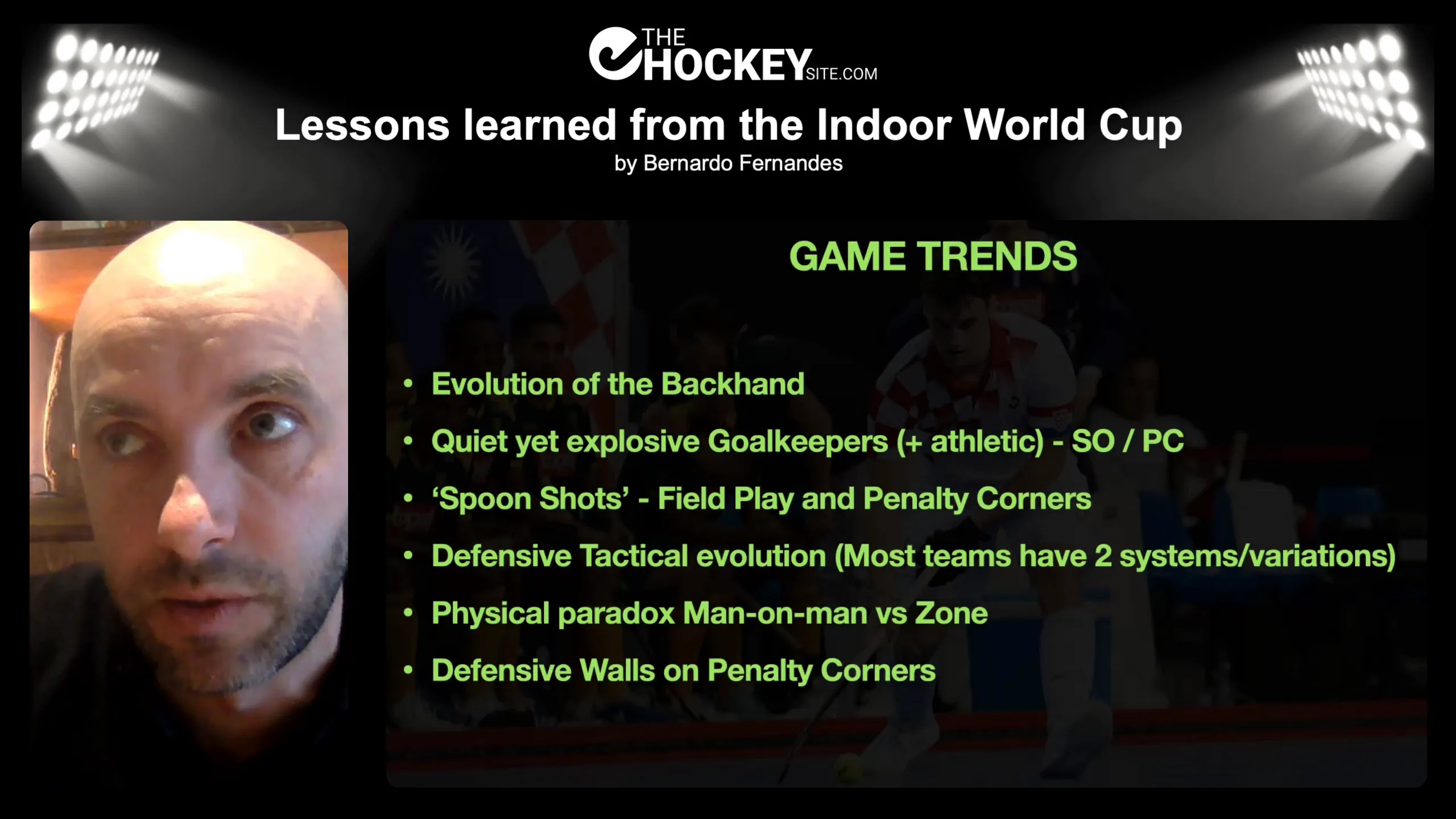
Lessons learned from the Indoor World Cup 2025
In this masterclass, we dive deep into the world of indoor hockey, exploring valuable lessons learned from the recent Indoor Hockey World Cup. Join Bernardo Fernandes as he shares his experiences and insights, offering guidance for coaches looking to enhance their teams’ performance in this fast-paced and dynamic sport.
Introduction to Indoor Hockey and the World Cup Experience
Indoor hockey is a thrilling variant of the traditional outdoor game, offering a fast-paced, dynamic environment that challenges players and coaches alike. The recent Indoor Hockey World Cup showcased not only the intensity of competition but also the unique strategies that define this sport. As a coach, understanding the nuances of indoor hockey can provide invaluable insights into team performance and game management.
My experience with the Croatian coaching staff during the World Cup was an eye-opening journey. It was a chance to witness firsthand the dedication, preparation, and passion that goes into competing at such a high level. The lessons learned extend beyond mere tactics; they encompass the emotional and psychological aspects that contribute to a team’s success.
Overview of the Indoor World Cup
The Indoor World Cup is a prestigious event that brings together the best teams from across the globe. This year’s tournament, hosted in Croatia, was particularly notable for its organizational excellence and the spirit of competition it fostered. The event not only highlighted the skills of individual players but also the collaborative efforts of coaching staffs who meticulously prepare their teams for success.

Throughout the tournament, the atmosphere was electric. Fans cheered passionately for their teams, and the players responded with skillful displays of hockey. The level of play was exceptional, with teams demonstrating both individual brilliance and cohesive teamwork. As coaches, we gathered insights that will inform our future strategies and player development.
Tournament Stats and European Dominance
Analyzing the tournament statistics reveals a clear trend: European teams dominated the competition. In both the men’s and women’s divisions, European nations consistently ranked at the top, showcasing their strength and depth in indoor hockey. This pattern underscores the importance of developing a robust hockey culture and infrastructure in these regions.

- In the men’s division, several European teams reached the semifinals, with the final match being a showcase of tactical brilliance and athleticism.
- The women’s division also saw European teams excel, highlighting the depth of talent across the continent.
- South Africa emerged as a refreshing presence, challenging the European stronghold with their dynamic style of play.
These statistics not only reflect the current state of indoor hockey but also serve as a benchmark for developing nations aiming to compete on the world stage. The challenge for emerging teams lies in building a competitive environment that nurtures talent and fosters a love for the game.
Key Rules and Their Impact on Play
The rules governing indoor hockey play a significant role in shaping the game’s dynamics. Recent changes, such as those concerning trapping and penalty corner defense, have sparked discussions among coaches and players alike. Understanding these rules is crucial for developing effective game strategies.

- The trapping rule aims to reduce instances where players become stuck in corners, but it has raised concerns about the implications for game flow and referee involvement.
- Mandatory helmet usage for penalty corner defenders has also been introduced, prompting debates about player safety and the timing of such regulations.
As coaches, we must adapt our tactics to these rules while ensuring our players are well-versed in the regulations. This adaptability can be the difference between success and failure in high-stakes matches.
Inside Look at Croatia’s Game Preparation
Preparation for the Indoor World Cup was an extensive process for the Croatian team. We focused on creating a comprehensive game plan that addressed both our strengths and the unique challenges posed by our opponents. This involved detailed analyses of potential competitors, particularly South Africa, which we had the opportunity to study closely.
Our game preparation included:
- Video analysis of opponents’ playing styles and strategies, allowing us to identify key players and their defensive systems.
- Implementing a flexible game plan that could adapt to different game scenarios, emphasizing the importance of momentum shifts.
- Engaging in physical conditioning and mental preparation to ensure players were at their best, both physically and psychologically.
By emphasizing teamwork and communication during our preparation, we aimed to foster an environment where players felt confident in executing the game plan. The success of this approach became evident as the tournament progressed.
Emerging Game Trends in Indoor Hockey
The Indoor Hockey World Cup revealed several emerging trends that are shaping the future of the sport. Notably, the evolution of backhand techniques and innovative shot styles are becoming increasingly prominent in players’ arsenals.
- Players are now expected to be proficient with both forehand and backhand techniques, allowing for more versatile offensive strategies.
- New shooting techniques, such as the “spoon shot,” are challenging goalkeepers and creating exciting scoring opportunities.
- Teams are increasingly employing multiple defensive systems, which adds complexity to game strategies and requires coaches to be more adaptable.
These trends not only enhance the excitement of the game but also provide coaches with new avenues for player development. Adapting training programs to incorporate these techniques can elevate a team’s performance on the international stage.
Defensive Strategies and Physical Demands
Defensive strategies in indoor hockey are evolving, with teams now employing a mix of zone and man-to-man systems. This adaptability is essential in responding to the dynamic nature of indoor play, where quick transitions and momentum shifts are commonplace.

Coaches must also consider the physical demands of these strategies:
- There is a paradox in how teams manage player fatigue; while a zonal system may seem less taxing, it can lead to overexertion of key players if not managed properly.
- Implementing a rotation system can help maintain player stamina without sacrificing defensive effectiveness.
Understanding these physical demands allows coaches to create training regimens that prepare players for the rigors of indoor hockey, ensuring they remain competitive throughout the tournament.
Showcasing Notable Goals and Techniques
The Indoor Hockey World Cup was a platform for showcasing remarkable goals and innovative techniques. Players exhibited a variety of skills that captivated audiences and left a lasting impression on coaches and spectators alike.
One standout moment was the execution of backhand shots, which have become increasingly popular in indoor hockey. These shots not only demonstrate a player’s skill but also their ability to think creatively under pressure.
In addition to backhand shots, the tournament featured several instances of “rolling shots,” where players skillfully maneuvered the ball to evade defenders. This technique highlights the importance of ball control and quick thinking during gameplay.
Teams like South Africa embraced a more attacking style, often opting for bold plays that resulted in thrilling goals. Their willingness to take risks paid off, showcasing how creativity can lead to success on the field.
Key Takeaways for Coaches
As coaches, we must extract valuable lessons from the Indoor Hockey World Cup. Here are three key takeaways that can enhance our training methodologies:
- Encourage Creativity: Inspired by the South African team’s flair, we should foster an environment that encourages players to be creative. Allow them to experiment with dribbling and unconventional plays.
- Focus on Penalty Corners: With the increasing difficulty of scoring, penalty corners have become crucial. Coaches should dedicate time to developing effective penalty corner strategies, as they often determine the outcome of matches.
- Master the Backhand: Emphasizing backhand techniques and the importance of the left glove can provide players with a tactical advantage. Coaches should integrate these elements into their training sessions.

The Role of Goalkeepers in Indoor Hockey
Goalkeepers play a more active role in indoor hockey compared to outdoor formats. Their ability to read the game and react quickly is paramount. During the tournament, we saw how top goalkeepers became game-changers in shootouts and critical moments.
Training for goalkeepers should include:
- Video analysis of opponents to anticipate shots and strategies.
- Regular practice of shootouts to build confidence and technique.
- Developing a calm and composed demeanor in high-pressure situations.
The Importance of Training and Player Development
Player development is a continuous process, and the lessons learned from the World Cup emphasize the need for targeted training. Coaches should focus on building a strong foundation of skills while also adapting to the evolving styles of play.
Key aspects of training include:
- Incorporating small-sided games to enhance decision-making under pressure.
- Focusing on specific skill development, such as ball control and shooting techniques.
- Encouraging teamwork and communication during practice sessions to foster a cohesive unit.
Conclusion and Future of Indoor Hockey
The Indoor Hockey World Cup has showcased the sport’s potential for growth and excitement. As coaches, we have a responsibility to nurture this talent and inspire the next generation of players.
By embracing creativity, refining our training approaches, and recognizing the importance of player development, we can elevate indoor hockey to new heights. The future is bright, and with continued effort, we can make indoor hockey a prominent force in the global sports arena.
Speaker
-
 Bernardo FernandesCoach
Bernardo FernandesCoachBernardo Fernandes 🇵🇹 is known through-out the world of hockey as the founder of Self-Pass. Among hockey coaches he is known as an educator for EHF & the FIH Academy. He was also once at the origins of what became thehockeysite.com. But in “regular life” he is a hockey coach, with club experience in Portugal, The Netherlands, Belgium and in recent years Germany and internationally with his Portugal.

